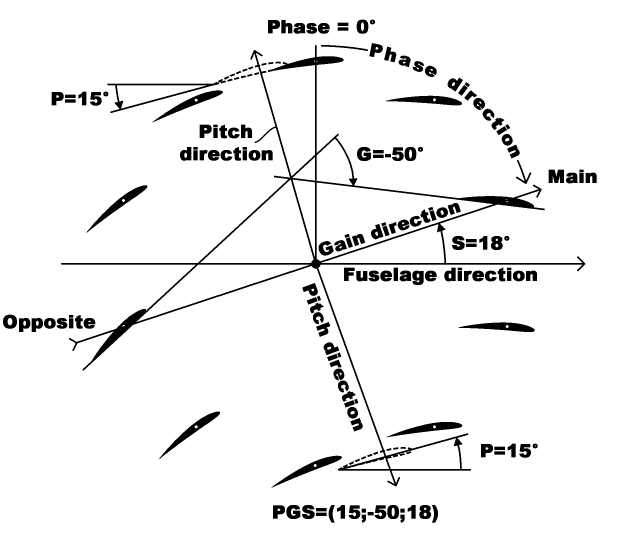

The handling of the liftoplane at the intermediate level is performed by steering the wings on its rotors. This steering needs some system for referring to the particular state of the steering. This system is defined here and it is referenced as PGS-state or just PGS. The PGS definition is represented in the diagram below and follows with an explanation.

The diagram images the rotor wings in some particular state of steering. The main idea of it is: the state is simply kinematic characteristics that are irrelevant to the current airflow condition. And so, it can be considered as a low level of handling of the aircraft. This may not be very convenient for use by the pilot, but at first it is intended only to have an exact reference. A straightforward way for it is to have the number of pitches equal to the number of wings. From the simulation examples we know that the aircraft can be handled by switching AoA from lifting value to recovery value and vice versa. But this AoA is a characteristic of the airflow condition, which will be out of the scope of the desired state. Nevertheless, consider that the desired state of the pitches can have some symmetry corresponding to a symmetrical state of these AoAs with some functional mapping between both states. So if the state of these AoAs can be characterized with two values in two opposed points and intermediate values between their, also the state of the pitches can be characterized in the same manner, where the intermediate values will be reflected by some function, which will depend on the particular implementation of the steering itself and will stay out of the scope of the referencing to the state of the pitches. In such a case, the referenced state will be reduced to only three parameters, where two of them will be related to two values at these opposite points and the third parameter will indicate the exact direction where these two opposite points are located.
An additional idea here: let's this system will possess some kind of neutrality in some particular cases. And it indeed exists, when the pitches of all wings are equal to some common angle. Let’s use this common angle as the first parameter of this referencing system and name it as "Pitch" with a referencing by the first letter "P" from the PGS abbreviation. The next parameter will characterize the level of violation of this neutrality, which is logically connected with a difference in the pitches of the wings at two specific opposite points. Let’s reference one of these points as "main" and the other as "opposite", where the word "main" is selected to reflect its impact on the lift force in many operations. And this parameter will be equal to the difference in the pitches between "main" and "opposite". And so, this is the second parameter, which has the name "Gain" and is referenced with the second letter "G". Finally, the remained third parameter will be simply the angular direction of the "main" point. I named the third parameter as "Skew", and I refer to it with the third letter "S". I selected this name, because here exists a logical connection with the "Skew" angle of the "conveyering wings” aircraft I described in the topic about evolution in respect of implementation of the “flying elevator”concept. That aircraft also can utilize the referencing to the PGS-state, although its Skew is fixed.
Now on the diagram we can see all the referred elements. Here are two Pitch directions, where the wings possess the neutrality with a particular "P" angle. Here is the Gain direction, i.e., Skew with the value "S", where the second parameter "G" can be measured. And finally, at the bottom, an example of such a reference is presented as a three-component vector: PGS=(15;-50;18). Here the values mean in degrees. It can also be written as (15°;-50°;18°). Additionally, the diagram presents a "Phase" parameter definition for a particular wing, which is beyond the scope of the PGS-state itself, but is used to recover an actual pitch for a particular wing after providing the entire PGS-state and this Phase into some routine that calculates the actual pitch using a particular implementation of the steering functionality.
Copyright © 2018-2023 Yuri Feldman - All Rights Reserved